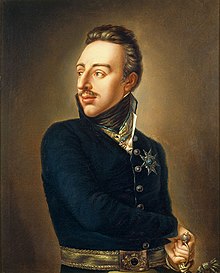This article needs additional citations for verification. (February 2022) |
| Gustav IV Adolf | |
|---|---|
 Portrait by Per Krafft the Younger, 1809 | |
| King of Sweden | |
| Reign | 29 March 1792 – 29 March 1809 |
| Coronation | 3 April 1800 |
| Predecessor | Gustav III |
| Successor | Charles XIII |
| Regent | Charles, Duke of Södermanland (1792–1796) |
| Born | 1 November 1778 Stockholm Palace, Kingdom of Sweden |
| Died | 7 February 1837 (aged 58) St. Gallen, Swiss Confederacy |
| Burial | 29 May 1884 |
| Spouse | |
| Issue | |
| House | Holstein-Gottorp |
| Father | Gustav III of Sweden |
| Mother | Sophia Magdalena of Denmark |
| Religion | Lutheran |
| Signature |  |
| Swedish royalty |
| House of Holstein-Gottorp |
|---|
 |
| Adolf Frederick |
| Gustav III |
| Gustav IV Adolf |
|
| Charles XIII |
|
Gustav IV Adolf or Gustav IV Adolph[1] (1 November 1778 – 7 February 1837) was King of Sweden from 1792 until he was deposed in a coup in 1809. He was also the last Swedish monarch to be the ruler of Finland.
The occupation of Finland in 1808–09 by Russian forces was the immediate cause of Gustav Adolf's overthrow, violently initiated by officers of his own army. Following his abdication on 29 March 1809, an Instrument of Government was hastily written, which severely circumscribed the powers of the monarchy. The "Instrument" was adopted in 1809 on 6 June, the National Day of Sweden now as well as in his time. It remained in force until replaced in 1974. The crown, now with strictly limited powers, passed to Gustav Adolf's uncle Charles XIII.[2]
- ^ David Williamson in Debrett's Kings and Queens of Europe ISBN 0-86350-194-X pp. 125, 134, 194, 207
- ^ Cronholm, Neander N. (1902). A History of Sweden from the Earliest Times to the Present Day. ch 37 pp. 203–219